Late October birding can get a bit monotonous. The usual winter residents are around but only a few belated summer migrants are left and the winter ducks aren’t yet driven close to shore by ice. I usually find something interesting whenever I’m out, though, whether it’s a Kool-aid drenched fungus, or some late flowering plants. This time, I saw a bird which was basically white and grey livened up with a black mask and it was being mobbed by Chickadees, Robins, Nuthatches and Goldfinches.
A Northern Shrike Tries to Visit Riverwood
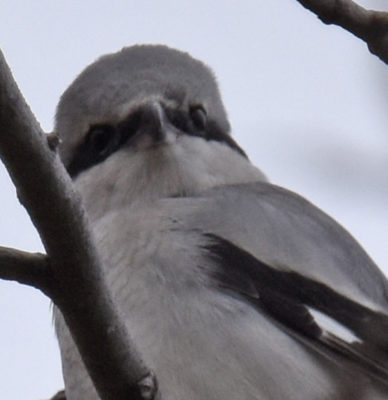
According to a helpful id article by Michael King and Ron Pittaway, the narrow white mark above the bill/nose is a field mark for the Northern Shrike.
I first saw this Northern Shrike perched in a shrub. I had focused on it for the same reason I focus on every Robin or Cardinal: I like to create a photo diary of what I’ve seen so I can write it up later at home. I was surprised to see the bird was grey and white and definitely not a Thrush. I thought I saw a black mask but the bird flew quickly so I wasn’t sure.
I had seen a Northern Shrike in the same area two years ago, so I was pretty hopeful. And I’ve never seen a Northern Mockingbird at Riverwood, so either way it was going to be a good bird.
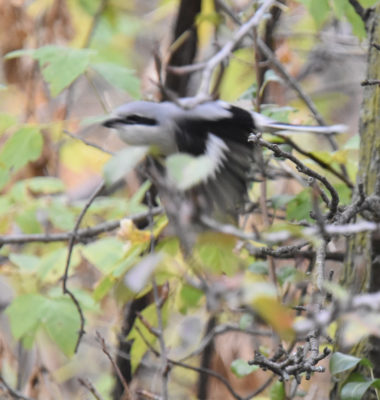
The white wing patches are really visible when the Northern Shrike flies.
Fortunately for me, it had flown only to get a better perch. It landed over the trail ahead of me in an almost bare tree. Of course there were branches and twigs in the way so I had trouble trying to get a clear look at it. And I was keeping well back. The only Shrike that I had seen well before was at Colonel Sam Smith Park: that one always flew if it noticed people approaching.
This one, frankly, didn’t care about me at all! I edged backwards and forwards trying to find a way to look at it without wood in the way. It stayed put. I was a bit surprised to see other birds on the tree with it.
When it moved, it just changed trees, choosing one out overlooking the marshy area bounded by the Red Deer trail and the Culham trail.
Where Should I Look for a Northern Shrike?
Like many predatory birds, Shrikes often perch up high where there is a good view. They often hunt over clearings. So when it moved the second time, I started checking near the tops of any bare or dead trees surrounding the marsh. Eventually I found it again.
Northern Shrikes literally do move north for the summer, usually up to the Taiga and Tundra of northern Canada and Alaska. But in the fall, they migrate down through and into southern Canada and the USA for the winter. Some over-winter in southern Ontario like the one at Colonel Samuel Smith Park in Toronto.
How Did I Know the Shrike Was a Predatory Bird?
One of the first ways I confirmed I was looking at a Shrike came when I looked at a close-up of its bill on my camera’s screen. There was a huge (to me) hook at the tip. Definitely not a Mockingbird bill!
Shrikes are an unusual predatory bird because they don’t have the typical hawk’s bill or falcon’s talons. These are the birds you may have heard about who sometimes impale their prey on thorns or twigs. I’ve read that it may be to “store” it until the prey softens and is easier to tear apart to eat, or that it’s because they have trouble holding it still without dropping it while they eat because they lack talons. I don’t know which, if either, theory is correct.
Small Birds Mob Predators Including This Northern Shrike
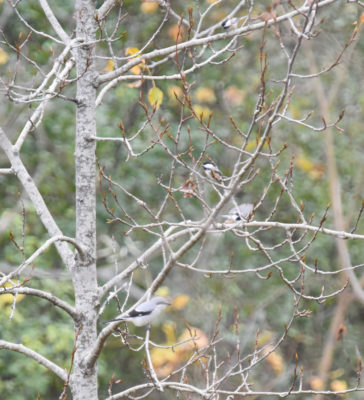
There are 3 Chickadees in the tree near, but not too close, to the Shrike, trying to drive it away.
When the Shrike moved to its fourth perch, I lost it. Then a minute or two later (after I hand fed the collection of Chickadees that egocentrically assumed I was stopped so I could attend to their breakfast) I heard a group of robins start calling. They were quickly joined by some Chickadees and Nuthatches.
I checked the area where the noise and fluttering was and sure enough found the Shrike again. It was trying to perch on a small tree or tall shrub but the local birds were not pleased. Quickly, the branches in the surrounding trees and shrubs filled with noisy, fluttering birds. They were mobbing the Shrike, trying to irritate it into moving on, and warning other birds of the exposed danger in their midst.
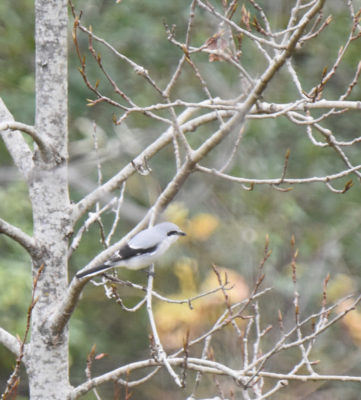
From a distance, the grey, white and black markings of the Shrike made it fairly easy to spot.
It worked. The Shrike winged off swiftly downstream along the Credit and out of view.
And I put my spare seeds down on a log, and started my patrol again, wondering what else I might find but happy that the day had already brought one memorable encounter.
Related Reading
- Warbling Vireo: Another Bird with a Hook at the Tip of Its Bill
- Hawks Hate Annoying Pests Around Their Heads, Too
- A Merlin in Southern Ontario
Join In
Do you see Northern Shrikes during their winter migration? Please share your sighting with a comment.

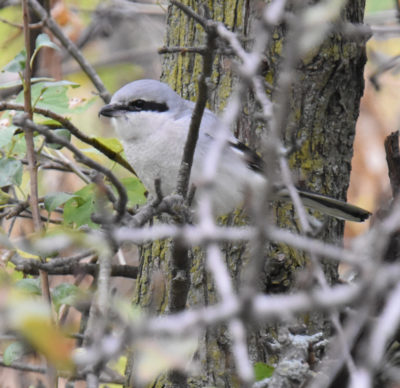
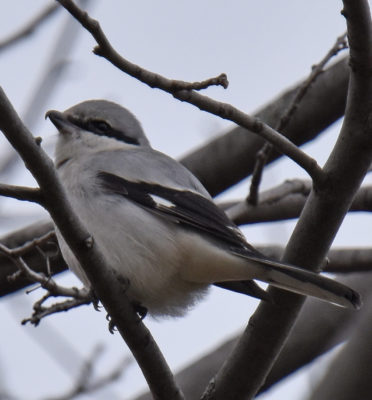
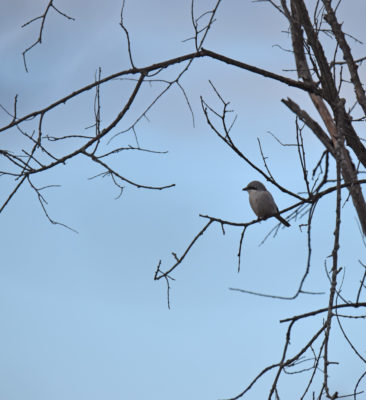
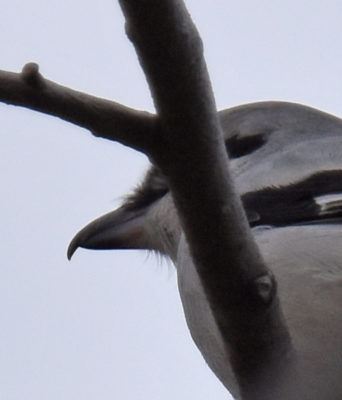
I just had a large group of these land in my half dried up “fish” pond scrambling for the rain water that has been collecting there.
Never had I seen one before this. Of course when they saw my camera phone they all disbursed in a split second. I am located in Austell, Georgia very near a small tributary changing into Sweetwater Creek eventually ending in the Chattahoochee.
This is a very interesting sighting because I’m not sure which birds you were seeing! Northern Shrikes don’t make it down to Georgia. I’m wondering if they were maybe Northern Mockingbirds? There’s some info on them on the Cornell Website at https://www.allaboutbirds.org/guide/Northern_Mockingbird/overview Either way, I envy you for seeing a flock like that!
Took pictures of one in Arizona desert just south of Phoenix, read this article to find out what it was
In Arizona it’s more likely it was a Loggerhead Shrike. They look almost identical. Up here in Ontario, Loggerheads are rare, (Northerns are more common here) so I envy your sighting!